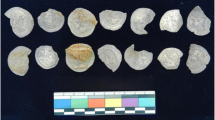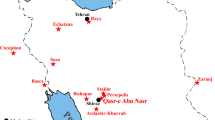Abstract
A metallurgical investigation was carried out on two early historic silver and copper punch marked coins. The objective was to study the metal composition, and the methods used in making of the early historic coins in India. The inductively coupled mass spectrometry was used to analyze the elemental composition of the coins. Metal formation and its mechanical properties were studied in physical metallurgical laboratory. The study revealed that the coins were not pure metal but an alloy. The silver coin contained copper as a major alloying element with other elements viz., V, Fe, Zn, Sn, Pb, As, Au in trace level while in copper the coin lead was the main alloying element with Ni, Fe, As, Au and Co in trace.












Similar content being viewed by others
Change history
23 December 2021
Due to a font problem some mistakes occurred that have been corrected.
References
Agrawal, O. P., Narain, H., & Prakash, J. (1990). Technical studies of silver punch mark coins from Narhan (Gorakhpur U.P.), India—600 BCE–200 BCE. Journal of the Historical Metallurgy Society, 24(2), 81–88.
Divija, M., Singh, M., & Lal, U. S. (2018). Examination and analysis of Indian silver punchmarked coins employing WD-XRF and other noninvasive techniques. Surface and Interface Analysis, 69(10), 947–953.
Mookerji, R. (1960). Chandragupta Maurya and his times, Madras University, Sir William Meyer Lectures, 1940–1941 (pp. 212–218). New Delhi: Motilal Banarsidass.
Rao, B. S., & Nair, M. V. (1991). A study of ancient punch marked silver coins, The Indian Journal of Numismatic Society of India, Vol. LIII, Parts I & II, 195–202.
Rautray, T. R., Suman, A. B. N., Nayak, S., Bipin, C., Tripathy, B., Saubhagyalaxmi, D., Das, B., Manas, R., Das, E., Satya, R., Das, F., & Chattopadhyay, P. K. (2011). Analysis of ancient Indian silver punch-marked coins by external PIXE. Applied Radiation and Isotopes, 69, 1385–1389.
Shamasastry, R. (1915). Kautilya’s Arthasastra (Eng. Tr.) (pp. 114–115). Mysore: Mysore Printing and Publishing.
Srivastava, D., Lal, U. S., Narain, H., & Nair, M. V. (2007). Technical studies of copper coins from Privitani Sarif, Bahraich. Conservation of Cultural Property of India, 37, 31–37.
Vijayan, V., Rautray, T. R., & Basa, D. K. (2004). EDXRF study of Indian silver punch marked coins. Nuclear Instruments and Methods in Physics Research, B, 225, 353–356.
Acknowledgements
The authors acknowledge the help of Shri Sankararaman for providing the coins for study.
Author information
Authors and Affiliations
Corresponding author
Rights and permissions
About this article
Cite this article
Sasisekaran, B., Raghunatha Rao, B. Archaeo-metallurgical study on two early historic punch marked coins. Indian J Hist. Sci. 56, 109–114 (2021). https://doi.org/10.1007/s43539-021-00014-0
Received:
Accepted:
Published:
Issue Date:
DOI: https://doi.org/10.1007/s43539-021-00014-0




